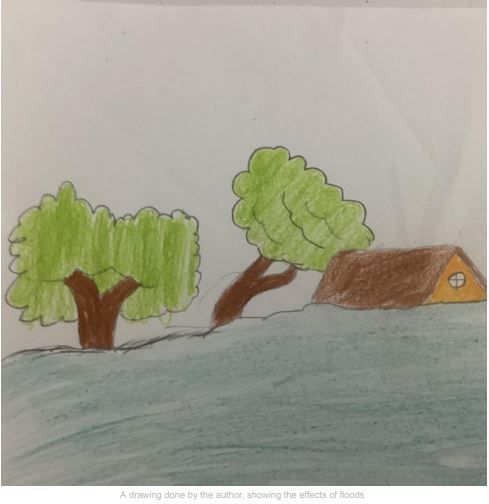Flooding: Understanding the Impacts and Implications of Floods

Imagine it is 2027, and you are living in the United Kingdom. At this time, a severe flood was washing over some parts of the United Kingdom. People were worried for their homes, businessmen and businesswomen were worried for their businesses, and farmers were worried for their farms. 55,000 homes were suffering from water ingress, and a whopping average of 500,000 people were stuck with no water or electricity. Thirteen people even lost their lives.
It doesn't sound great, in fact, it sounds terrible, which is why we are lucky to not be victims of floods. So let me take you on a journey of these formidable forces of nature.
What are floods?
Let's start with some basic knowledge - what are floods? - Floods are natural disaster which includes water overflowing past the normal limits of the water body. They can be very fascinating, but they can be very frightening. Floods can cause properties to be destroyed, loss of livestock, and even loss of human life. Some major floods that happened in the last ten years are the 2015 South Indian Floods, the 2014 Kashmir floods, and the 2011 Thailand floods, in which an unbelievable 65 out of 77 provinces were affected in some way by the floods.
If we aren't victims of floods, why should we care?
The answer is very simple. It's simply bad for the economy. When a flood hits a certain region, all the skilled workers and labourers might emigrate to a different area. Additionally, floods can cause a lot of damage to roads, bridges and buildings. This can be very expensive to repair.
What can I do to reduce the risk of floods?
Even though it is not possible to completely stop a flood, as it is something that naturally happens, there are some ways to minimise the impact of a flood. It's not only rather tremendous things that have an impact on floods, but some small things can have a big impact.
Think about it, we can try to dispose of waste properly, we can plant trees, and we can maintain drainage systems. While these might seem like minuscule changes to our daily lifestyle, they can have a huge impact on the amount of flooding that happens in your area.
We can also take bigger steps and use flood barriers which can help to prevent water from spreading past the designed area of the barriers. We can also steer clear of building things in areas which have a high risk of flooding. Raising awareness of floods is also tremendously important. This is because people won't try to reduce the effects of floods if they are not aware of them.
Facts about Floods
According to the United Nations Food and Agriculture Organization (FAO), 83% of the loss in herds and agriculture is caused by floods alone.
Around 1.81 billion people, which is almost a quarter of the world's population, are affected by 100-year floods, which are floods that happen every 100 years.
The Netherlands have the highest flood vulnerability in the world, with almost 60% of the whole nation exposed to floods.
The most expensive flood in the world is the Thailand flood, costing an unbelievable amount of £30 billion.
In the United States of America, floods cause 100 deaths every year. And the United States of America is not even in the top 25 countries most vulnerable to floods every year.
Conclusion
And that concludes this piece of writing. While floods may certainly seem like an interesting phenomenon, they are very dangerous. They are in fact, one of the most dangerous, deadly, damaging disasters ever. But together, if we try to reduce the effects of the floods, if we try to raise awareness, we can make a bit of a difference.
References
Pitt, M. (2008). Learning lessons from the 2007 floods.
Flood Management Info. (2013, 5th September). What are the negative social impacts of flooding? Retrieved from https://www.floodmanagement.info/what-are-the-negative-social-impacts-of-flooding/
Gale, E.L. and Saunders, M.A. (2013), The 2011 Thailand flood: climate causes and return periods. Weather, 68: 233-237. https://doi.org/10.1002/wea.2133
Alcoforado FAG (2018) Flood Control and its Management. J Atmos Earth Sci 1: 005.
Rentschler, J., Salhab, M. & Jafino, B.A. Flood exposure and poverty in 188 countries. Nat Commun 13, 3527 (2022). https://doi.org/10.1038/s41467-022-30727-4
Visual Capitalist. (2021, September 22). Countries with the highest flood risk. Retrieved March 11, 2023, from https://www.visualcapitalist.com/countries-highest-flood-risk/
World Atlas. (2019, May 29). The Most Catastrophic Floods in the World and Their Costly Impact. Retrieved from https://www.worldatlas.com/articles/the-most-catastrophic-floods-in-the-world-and-their-costly-impact.html
Diane Boudreau, Melissa McDaniel, Erin Sprout, Andrew Turgeon, (n.d.). Flood. National Geographic Society. Retrieved March 12, 2023, from https://education.nationalgeographic.org/resource/flood/
Author Biography
Daniyal Shamoon Qasim is a 12-year old boy who lives in Hithadhoo, Addu City, The Maldives. He enjoys playing football and tabletop games such as UNO and Scrabble. He studies in Grade 7 at Billabong High International School in Addu City, The Maldives.

Cite this article as:
Daniyal Shamoon Qasim, Flooding: Understanding the Impacts and Implications of Floods, theCircle Composition, Volume 4, (2023).
